Organizational Learning and Change: Tata Motors Case Study
VerifiedAdded on 2022/11/15
|19
|3891
|374
AI Summary
Read this case study on Tata Motors and learn about the internal and external analysis, literature review, possible strategies, and recommendations for change management.
Contribute Materials
Your contribution can guide someone’s learning journey. Share your
documents today.
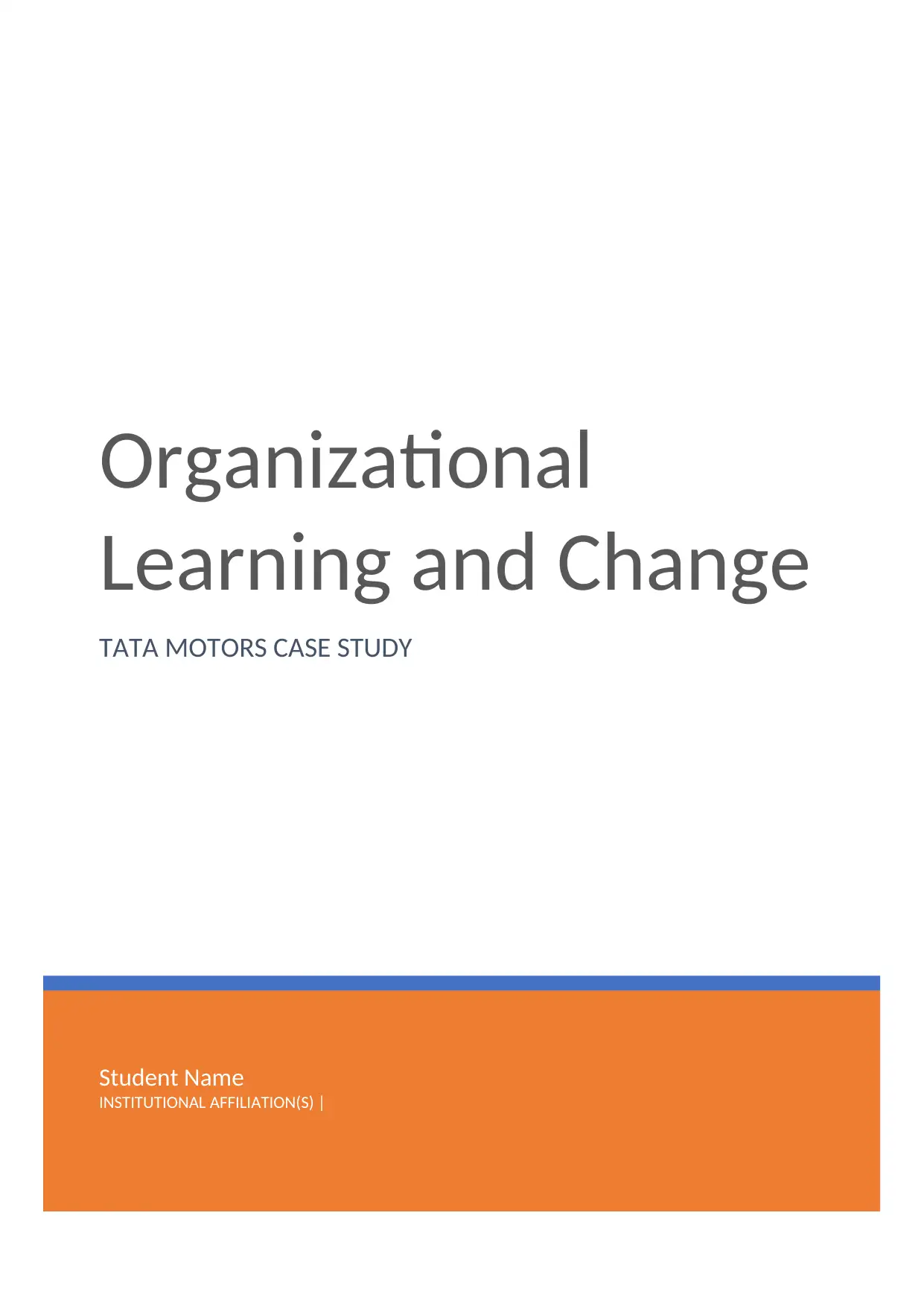
Student Name
INSTITUTIONAL AFFILIATION(S) |
Organizational
Learning and Change
TATA MOTORS CASE STUDY
INSTITUTIONAL AFFILIATION(S) |
Organizational
Learning and Change
TATA MOTORS CASE STUDY
Secure Best Marks with AI Grader
Need help grading? Try our AI Grader for instant feedback on your assignments.
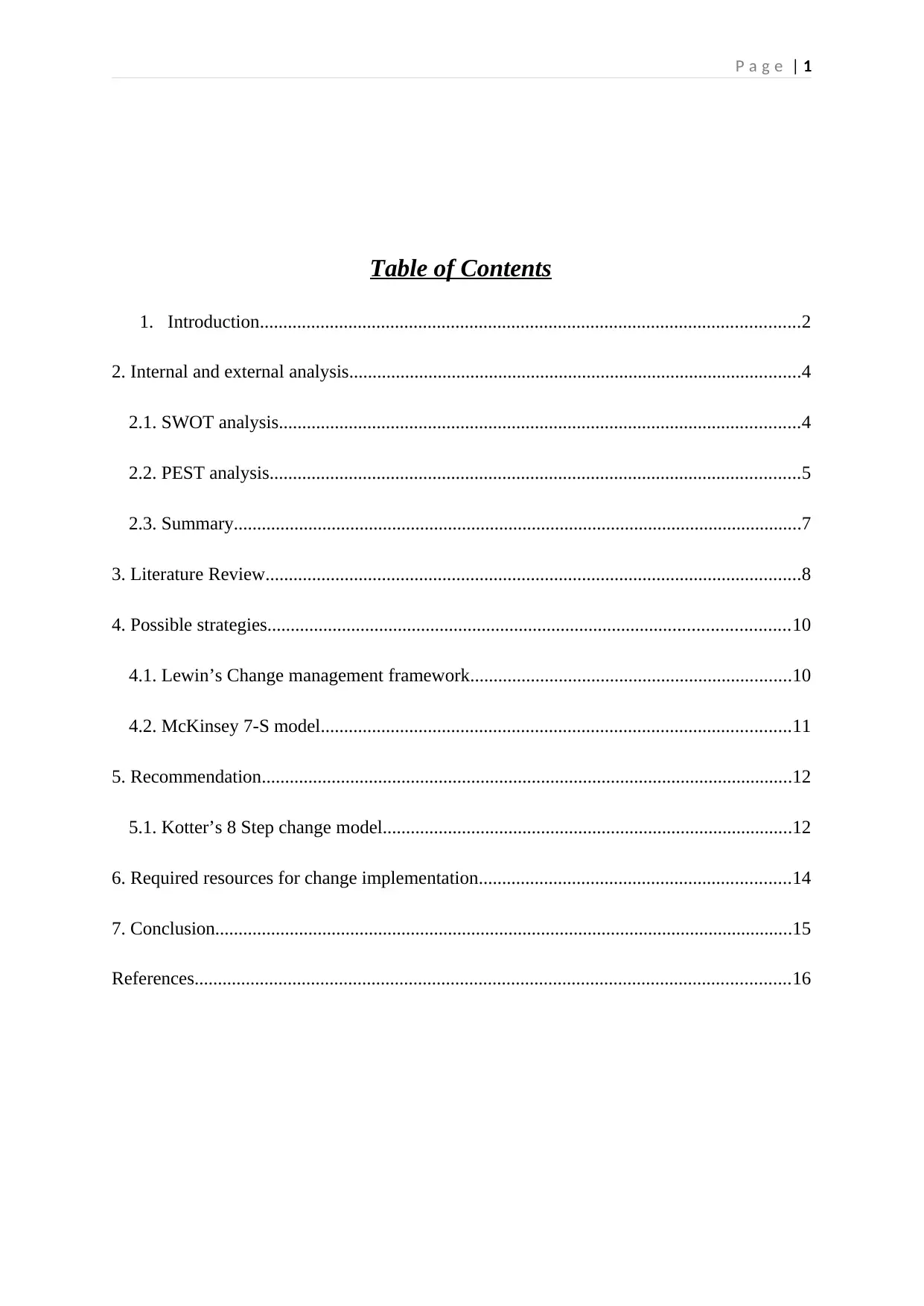
P a g e | 1
Table of Contents
1. Introduction....................................................................................................................2
2. Internal and external analysis.................................................................................................4
2.1. SWOT analysis................................................................................................................4
2.2. PEST analysis..................................................................................................................5
2.3. Summary..........................................................................................................................7
3. Literature Review...................................................................................................................8
4. Possible strategies................................................................................................................10
4.1. Lewin’s Change management framework.....................................................................10
4.2. McKinsey 7-S model.....................................................................................................11
5. Recommendation..................................................................................................................12
5.1. Kotter’s 8 Step change model........................................................................................12
6. Required resources for change implementation...................................................................14
7. Conclusion............................................................................................................................15
References................................................................................................................................16
Table of Contents
1. Introduction....................................................................................................................2
2. Internal and external analysis.................................................................................................4
2.1. SWOT analysis................................................................................................................4
2.2. PEST analysis..................................................................................................................5
2.3. Summary..........................................................................................................................7
3. Literature Review...................................................................................................................8
4. Possible strategies................................................................................................................10
4.1. Lewin’s Change management framework.....................................................................10
4.2. McKinsey 7-S model.....................................................................................................11
5. Recommendation..................................................................................................................12
5.1. Kotter’s 8 Step change model........................................................................................12
6. Required resources for change implementation...................................................................14
7. Conclusion............................................................................................................................15
References................................................................................................................................16
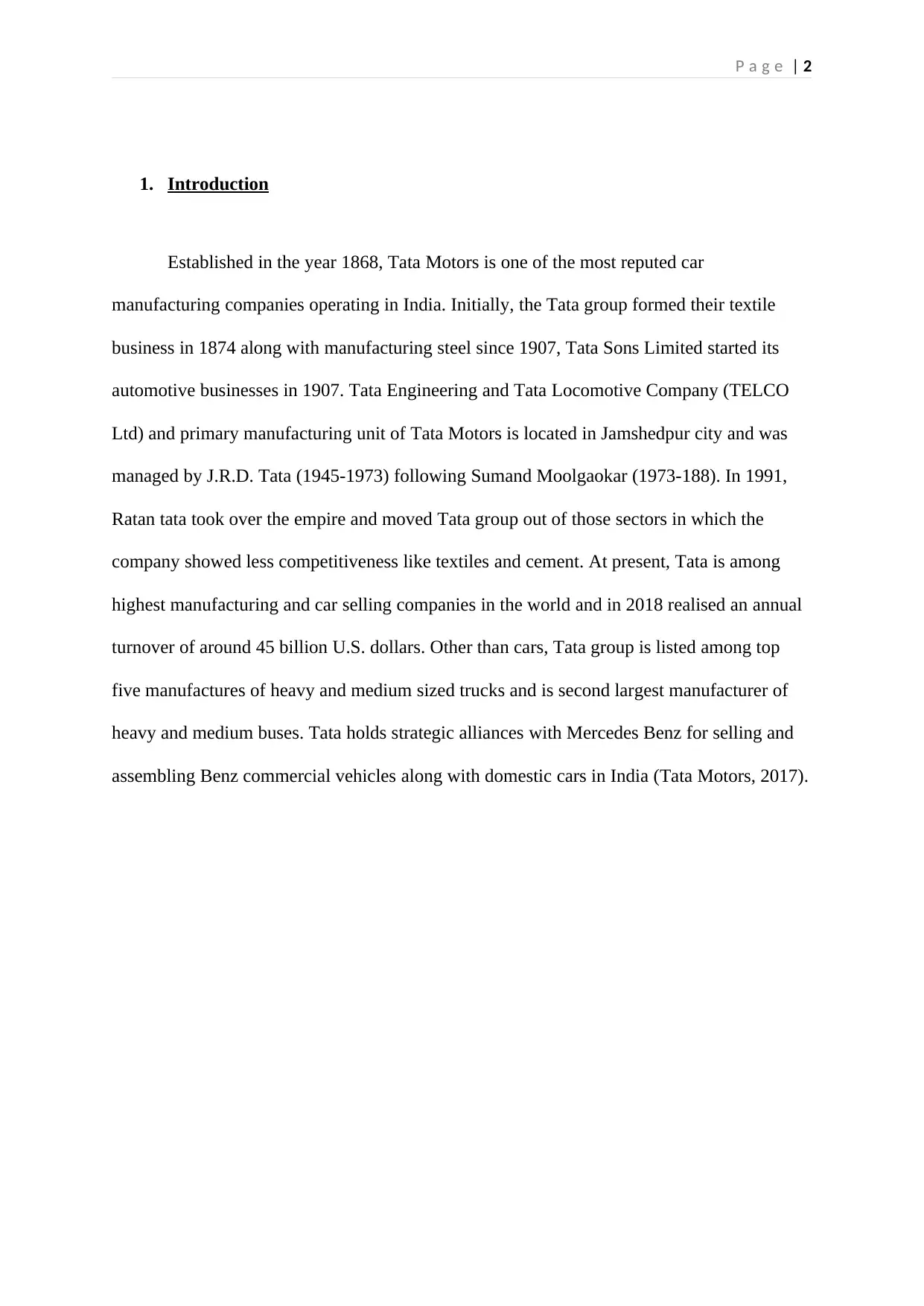
P a g e | 2
1. Introduction
Established in the year 1868, Tata Motors is one of the most reputed car
manufacturing companies operating in India. Initially, the Tata group formed their textile
business in 1874 along with manufacturing steel since 1907, Tata Sons Limited started its
automotive businesses in 1907. Tata Engineering and Tata Locomotive Company (TELCO
Ltd) and primary manufacturing unit of Tata Motors is located in Jamshedpur city and was
managed by J.R.D. Tata (1945-1973) following Sumand Moolgaokar (1973-188). In 1991,
Ratan tata took over the empire and moved Tata group out of those sectors in which the
company showed less competitiveness like textiles and cement. At present, Tata is among
highest manufacturing and car selling companies in the world and in 2018 realised an annual
turnover of around 45 billion U.S. dollars. Other than cars, Tata group is listed among top
five manufactures of heavy and medium sized trucks and is second largest manufacturer of
heavy and medium buses. Tata holds strategic alliances with Mercedes Benz for selling and
assembling Benz commercial vehicles along with domestic cars in India (Tata Motors, 2017).
1. Introduction
Established in the year 1868, Tata Motors is one of the most reputed car
manufacturing companies operating in India. Initially, the Tata group formed their textile
business in 1874 along with manufacturing steel since 1907, Tata Sons Limited started its
automotive businesses in 1907. Tata Engineering and Tata Locomotive Company (TELCO
Ltd) and primary manufacturing unit of Tata Motors is located in Jamshedpur city and was
managed by J.R.D. Tata (1945-1973) following Sumand Moolgaokar (1973-188). In 1991,
Ratan tata took over the empire and moved Tata group out of those sectors in which the
company showed less competitiveness like textiles and cement. At present, Tata is among
highest manufacturing and car selling companies in the world and in 2018 realised an annual
turnover of around 45 billion U.S. dollars. Other than cars, Tata group is listed among top
five manufactures of heavy and medium sized trucks and is second largest manufacturer of
heavy and medium buses. Tata holds strategic alliances with Mercedes Benz for selling and
assembling Benz commercial vehicles along with domestic cars in India (Tata Motors, 2017).
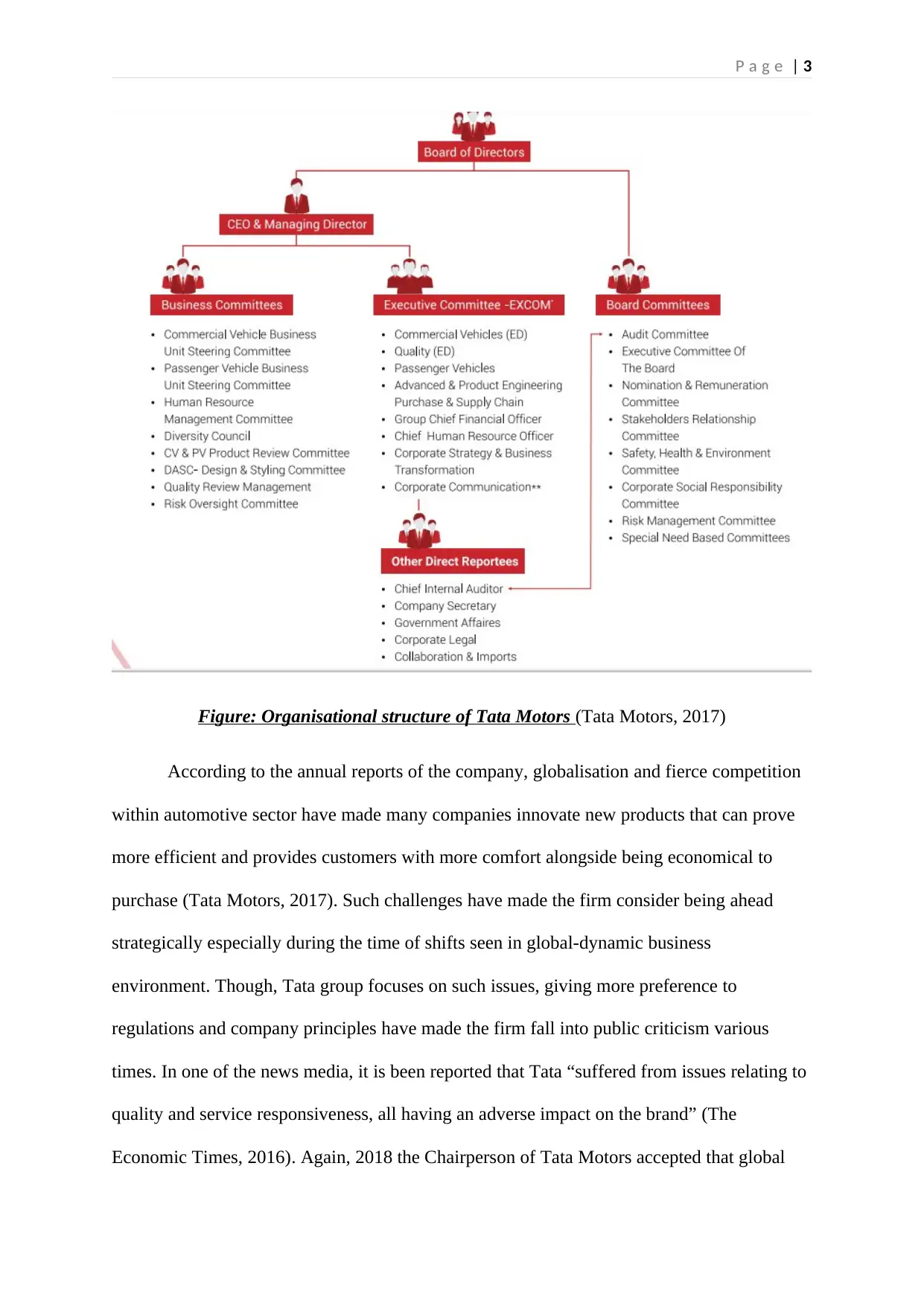
P a g e | 3
Figure: Organisational structure of Tata Motors (Tata Motors, 2017)
According to the annual reports of the company, globalisation and fierce competition
within automotive sector have made many companies innovate new products that can prove
more efficient and provides customers with more comfort alongside being economical to
purchase (Tata Motors, 2017). Such challenges have made the firm consider being ahead
strategically especially during the time of shifts seen in global-dynamic business
environment. Though, Tata group focuses on such issues, giving more preference to
regulations and company principles have made the firm fall into public criticism various
times. In one of the news media, it is been reported that Tata “suffered from issues relating to
quality and service responsiveness, all having an adverse impact on the brand” (The
Economic Times, 2016). Again, 2018 the Chairperson of Tata Motors accepted that global
Figure: Organisational structure of Tata Motors (Tata Motors, 2017)
According to the annual reports of the company, globalisation and fierce competition
within automotive sector have made many companies innovate new products that can prove
more efficient and provides customers with more comfort alongside being economical to
purchase (Tata Motors, 2017). Such challenges have made the firm consider being ahead
strategically especially during the time of shifts seen in global-dynamic business
environment. Though, Tata group focuses on such issues, giving more preference to
regulations and company principles have made the firm fall into public criticism various
times. In one of the news media, it is been reported that Tata “suffered from issues relating to
quality and service responsiveness, all having an adverse impact on the brand” (The
Economic Times, 2016). Again, 2018 the Chairperson of Tata Motors accepted that global
Secure Best Marks with AI Grader
Need help grading? Try our AI Grader for instant feedback on your assignments.
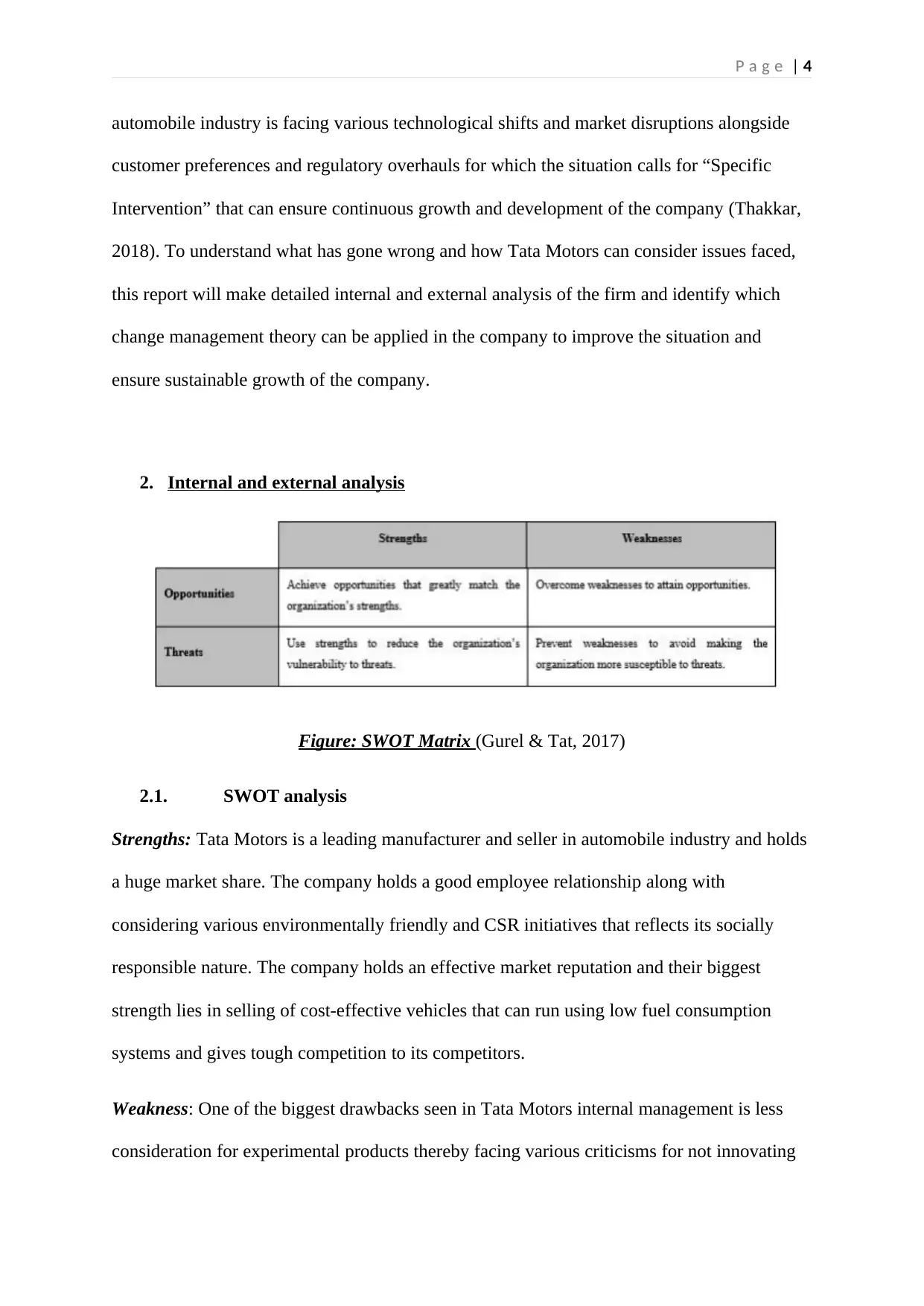
P a g e | 4
automobile industry is facing various technological shifts and market disruptions alongside
customer preferences and regulatory overhauls for which the situation calls for “Specific
Intervention” that can ensure continuous growth and development of the company (Thakkar,
2018). To understand what has gone wrong and how Tata Motors can consider issues faced,
this report will make detailed internal and external analysis of the firm and identify which
change management theory can be applied in the company to improve the situation and
ensure sustainable growth of the company.
2. Internal and external analysis
Figure: SWOT Matrix (Gurel & Tat, 2017)
2.1. SWOT analysis
Strengths: Tata Motors is a leading manufacturer and seller in automobile industry and holds
a huge market share. The company holds a good employee relationship along with
considering various environmentally friendly and CSR initiatives that reflects its socially
responsible nature. The company holds an effective market reputation and their biggest
strength lies in selling of cost-effective vehicles that can run using low fuel consumption
systems and gives tough competition to its competitors.
Weakness: One of the biggest drawbacks seen in Tata Motors internal management is less
consideration for experimental products thereby facing various criticisms for not innovating
automobile industry is facing various technological shifts and market disruptions alongside
customer preferences and regulatory overhauls for which the situation calls for “Specific
Intervention” that can ensure continuous growth and development of the company (Thakkar,
2018). To understand what has gone wrong and how Tata Motors can consider issues faced,
this report will make detailed internal and external analysis of the firm and identify which
change management theory can be applied in the company to improve the situation and
ensure sustainable growth of the company.
2. Internal and external analysis
Figure: SWOT Matrix (Gurel & Tat, 2017)
2.1. SWOT analysis
Strengths: Tata Motors is a leading manufacturer and seller in automobile industry and holds
a huge market share. The company holds a good employee relationship along with
considering various environmentally friendly and CSR initiatives that reflects its socially
responsible nature. The company holds an effective market reputation and their biggest
strength lies in selling of cost-effective vehicles that can run using low fuel consumption
systems and gives tough competition to its competitors.
Weakness: One of the biggest drawbacks seen in Tata Motors internal management is less
consideration for experimental products thereby facing various criticisms for not innovating
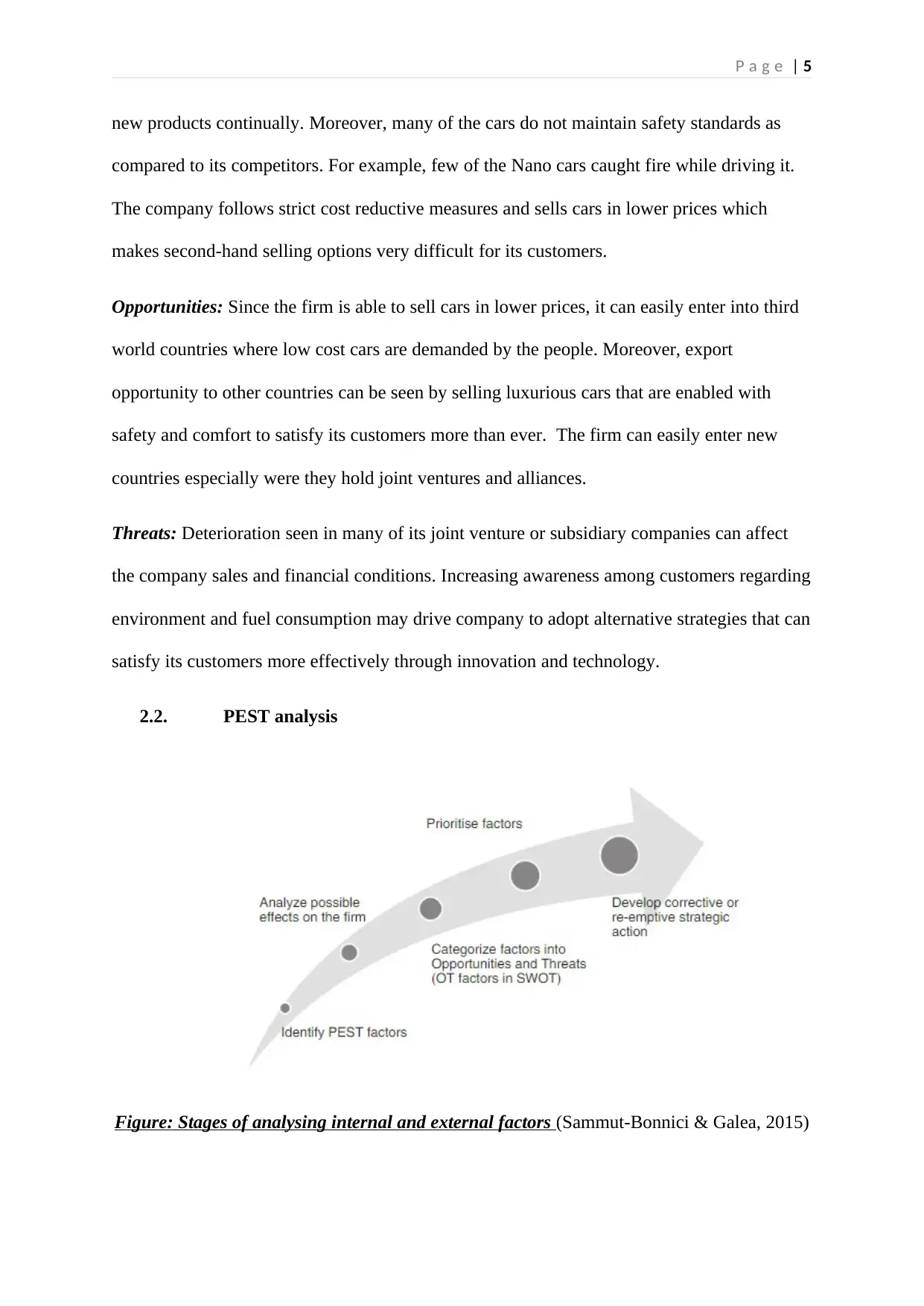
P a g e | 5
new products continually. Moreover, many of the cars do not maintain safety standards as
compared to its competitors. For example, few of the Nano cars caught fire while driving it.
The company follows strict cost reductive measures and sells cars in lower prices which
makes second-hand selling options very difficult for its customers.
Opportunities: Since the firm is able to sell cars in lower prices, it can easily enter into third
world countries where low cost cars are demanded by the people. Moreover, export
opportunity to other countries can be seen by selling luxurious cars that are enabled with
safety and comfort to satisfy its customers more than ever. The firm can easily enter new
countries especially were they hold joint ventures and alliances.
Threats: Deterioration seen in many of its joint venture or subsidiary companies can affect
the company sales and financial conditions. Increasing awareness among customers regarding
environment and fuel consumption may drive company to adopt alternative strategies that can
satisfy its customers more effectively through innovation and technology.
2.2. PEST analysis
Figure: Stages of analysing internal and external factors (Sammut-Bonnici & Galea, 2015)
new products continually. Moreover, many of the cars do not maintain safety standards as
compared to its competitors. For example, few of the Nano cars caught fire while driving it.
The company follows strict cost reductive measures and sells cars in lower prices which
makes second-hand selling options very difficult for its customers.
Opportunities: Since the firm is able to sell cars in lower prices, it can easily enter into third
world countries where low cost cars are demanded by the people. Moreover, export
opportunity to other countries can be seen by selling luxurious cars that are enabled with
safety and comfort to satisfy its customers more than ever. The firm can easily enter new
countries especially were they hold joint ventures and alliances.
Threats: Deterioration seen in many of its joint venture or subsidiary companies can affect
the company sales and financial conditions. Increasing awareness among customers regarding
environment and fuel consumption may drive company to adopt alternative strategies that can
satisfy its customers more effectively through innovation and technology.
2.2. PEST analysis
Figure: Stages of analysing internal and external factors (Sammut-Bonnici & Galea, 2015)
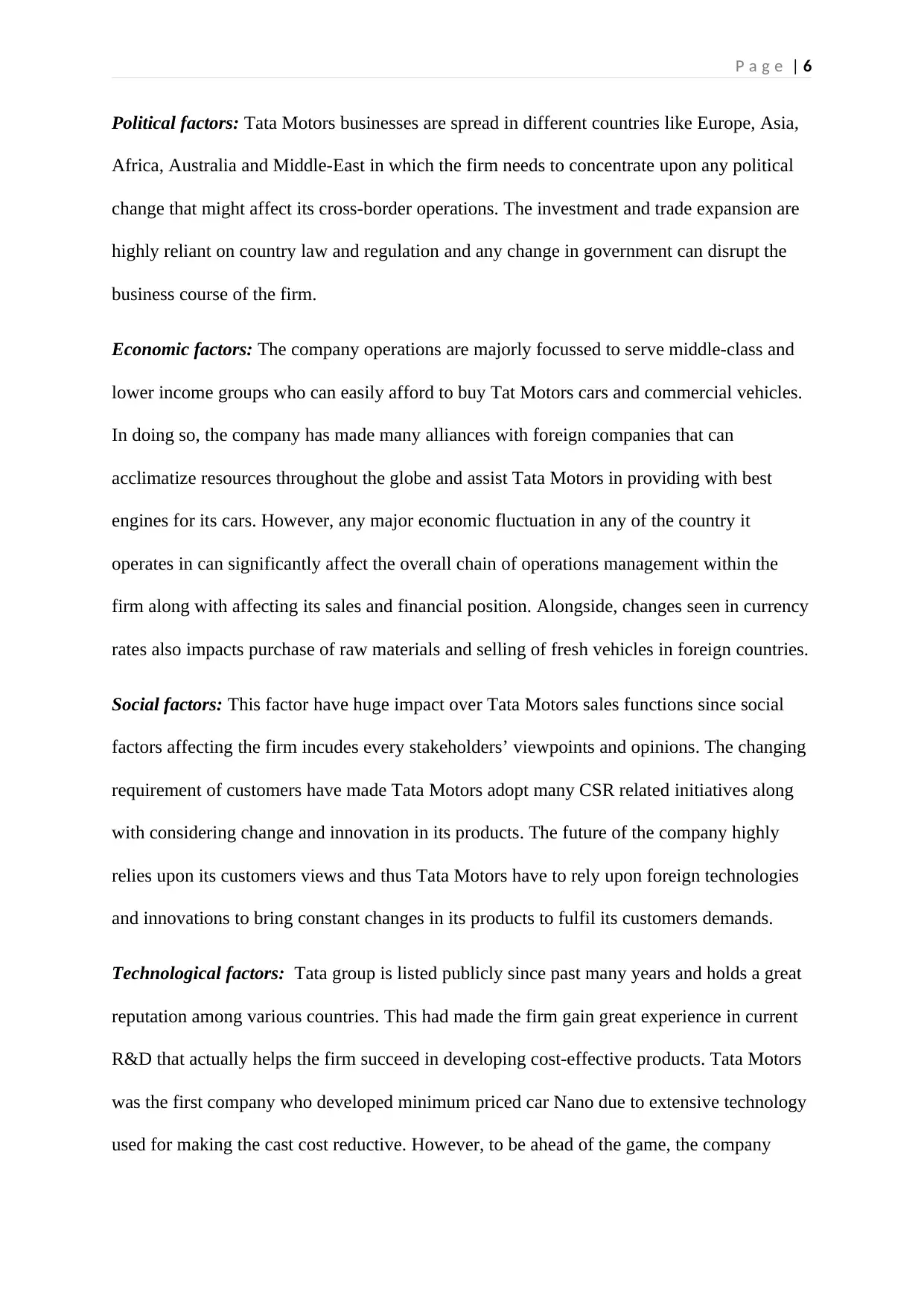
P a g e | 6
Political factors: Tata Motors businesses are spread in different countries like Europe, Asia,
Africa, Australia and Middle-East in which the firm needs to concentrate upon any political
change that might affect its cross-border operations. The investment and trade expansion are
highly reliant on country law and regulation and any change in government can disrupt the
business course of the firm.
Economic factors: The company operations are majorly focussed to serve middle-class and
lower income groups who can easily afford to buy Tat Motors cars and commercial vehicles.
In doing so, the company has made many alliances with foreign companies that can
acclimatize resources throughout the globe and assist Tata Motors in providing with best
engines for its cars. However, any major economic fluctuation in any of the country it
operates in can significantly affect the overall chain of operations management within the
firm along with affecting its sales and financial position. Alongside, changes seen in currency
rates also impacts purchase of raw materials and selling of fresh vehicles in foreign countries.
Social factors: This factor have huge impact over Tata Motors sales functions since social
factors affecting the firm incudes every stakeholders’ viewpoints and opinions. The changing
requirement of customers have made Tata Motors adopt many CSR related initiatives along
with considering change and innovation in its products. The future of the company highly
relies upon its customers views and thus Tata Motors have to rely upon foreign technologies
and innovations to bring constant changes in its products to fulfil its customers demands.
Technological factors: Tata group is listed publicly since past many years and holds a great
reputation among various countries. This had made the firm gain great experience in current
R&D that actually helps the firm succeed in developing cost-effective products. Tata Motors
was the first company who developed minimum priced car Nano due to extensive technology
used for making the cast cost reductive. However, to be ahead of the game, the company
Political factors: Tata Motors businesses are spread in different countries like Europe, Asia,
Africa, Australia and Middle-East in which the firm needs to concentrate upon any political
change that might affect its cross-border operations. The investment and trade expansion are
highly reliant on country law and regulation and any change in government can disrupt the
business course of the firm.
Economic factors: The company operations are majorly focussed to serve middle-class and
lower income groups who can easily afford to buy Tat Motors cars and commercial vehicles.
In doing so, the company has made many alliances with foreign companies that can
acclimatize resources throughout the globe and assist Tata Motors in providing with best
engines for its cars. However, any major economic fluctuation in any of the country it
operates in can significantly affect the overall chain of operations management within the
firm along with affecting its sales and financial position. Alongside, changes seen in currency
rates also impacts purchase of raw materials and selling of fresh vehicles in foreign countries.
Social factors: This factor have huge impact over Tata Motors sales functions since social
factors affecting the firm incudes every stakeholders’ viewpoints and opinions. The changing
requirement of customers have made Tata Motors adopt many CSR related initiatives along
with considering change and innovation in its products. The future of the company highly
relies upon its customers views and thus Tata Motors have to rely upon foreign technologies
and innovations to bring constant changes in its products to fulfil its customers demands.
Technological factors: Tata group is listed publicly since past many years and holds a great
reputation among various countries. This had made the firm gain great experience in current
R&D that actually helps the firm succeed in developing cost-effective products. Tata Motors
was the first company who developed minimum priced car Nano due to extensive technology
used for making the cast cost reductive. However, to be ahead of the game, the company
Paraphrase This Document
Need a fresh take? Get an instant paraphrase of this document with our AI Paraphraser
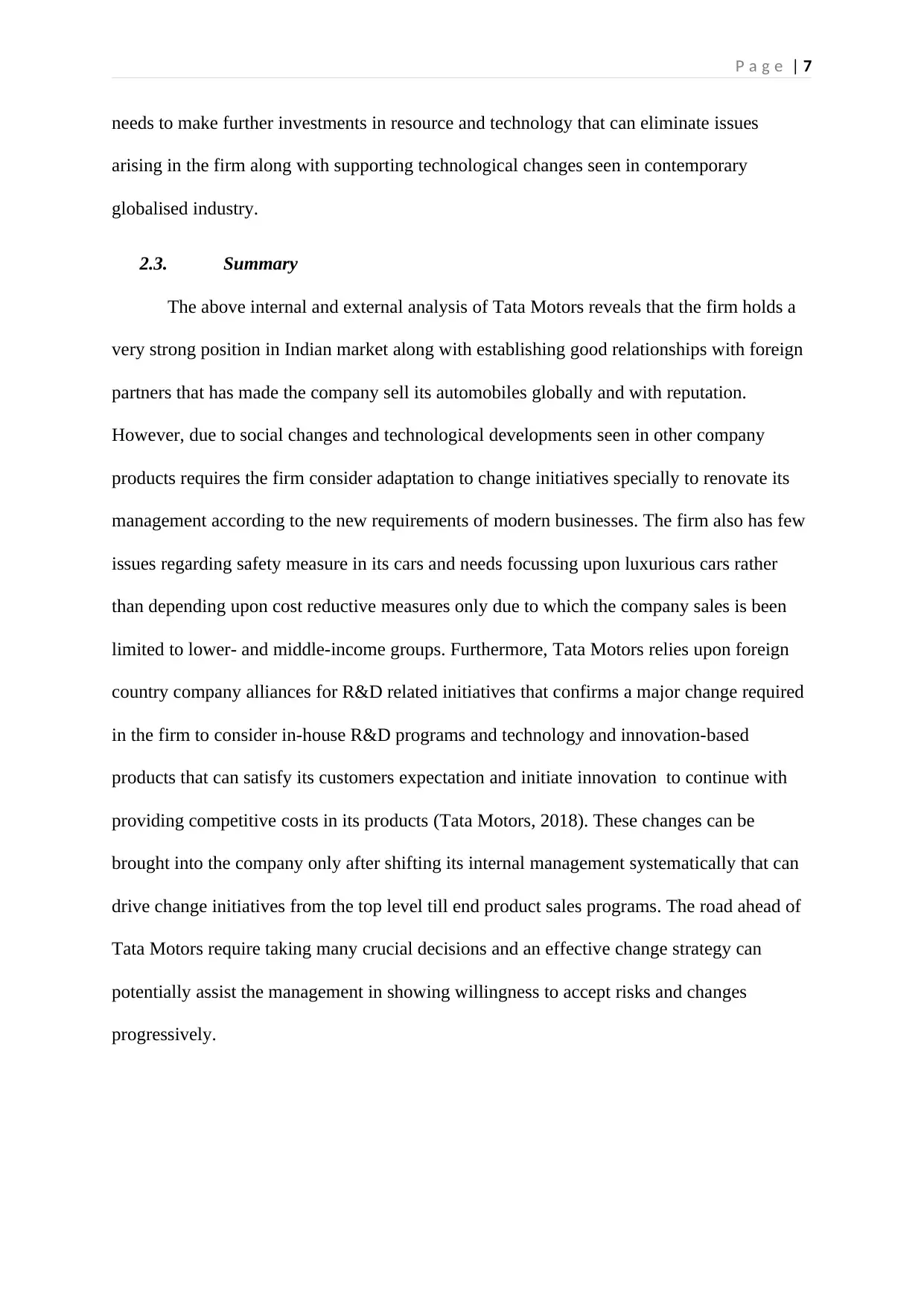
P a g e | 7
needs to make further investments in resource and technology that can eliminate issues
arising in the firm along with supporting technological changes seen in contemporary
globalised industry.
2.3. Summary
The above internal and external analysis of Tata Motors reveals that the firm holds a
very strong position in Indian market along with establishing good relationships with foreign
partners that has made the company sell its automobiles globally and with reputation.
However, due to social changes and technological developments seen in other company
products requires the firm consider adaptation to change initiatives specially to renovate its
management according to the new requirements of modern businesses. The firm also has few
issues regarding safety measure in its cars and needs focussing upon luxurious cars rather
than depending upon cost reductive measures only due to which the company sales is been
limited to lower- and middle-income groups. Furthermore, Tata Motors relies upon foreign
country company alliances for R&D related initiatives that confirms a major change required
in the firm to consider in-house R&D programs and technology and innovation-based
products that can satisfy its customers expectation and initiate innovation to continue with
providing competitive costs in its products (Tata Motors, 2018). These changes can be
brought into the company only after shifting its internal management systematically that can
drive change initiatives from the top level till end product sales programs. The road ahead of
Tata Motors require taking many crucial decisions and an effective change strategy can
potentially assist the management in showing willingness to accept risks and changes
progressively.
needs to make further investments in resource and technology that can eliminate issues
arising in the firm along with supporting technological changes seen in contemporary
globalised industry.
2.3. Summary
The above internal and external analysis of Tata Motors reveals that the firm holds a
very strong position in Indian market along with establishing good relationships with foreign
partners that has made the company sell its automobiles globally and with reputation.
However, due to social changes and technological developments seen in other company
products requires the firm consider adaptation to change initiatives specially to renovate its
management according to the new requirements of modern businesses. The firm also has few
issues regarding safety measure in its cars and needs focussing upon luxurious cars rather
than depending upon cost reductive measures only due to which the company sales is been
limited to lower- and middle-income groups. Furthermore, Tata Motors relies upon foreign
country company alliances for R&D related initiatives that confirms a major change required
in the firm to consider in-house R&D programs and technology and innovation-based
products that can satisfy its customers expectation and initiate innovation to continue with
providing competitive costs in its products (Tata Motors, 2018). These changes can be
brought into the company only after shifting its internal management systematically that can
drive change initiatives from the top level till end product sales programs. The road ahead of
Tata Motors require taking many crucial decisions and an effective change strategy can
potentially assist the management in showing willingness to accept risks and changes
progressively.
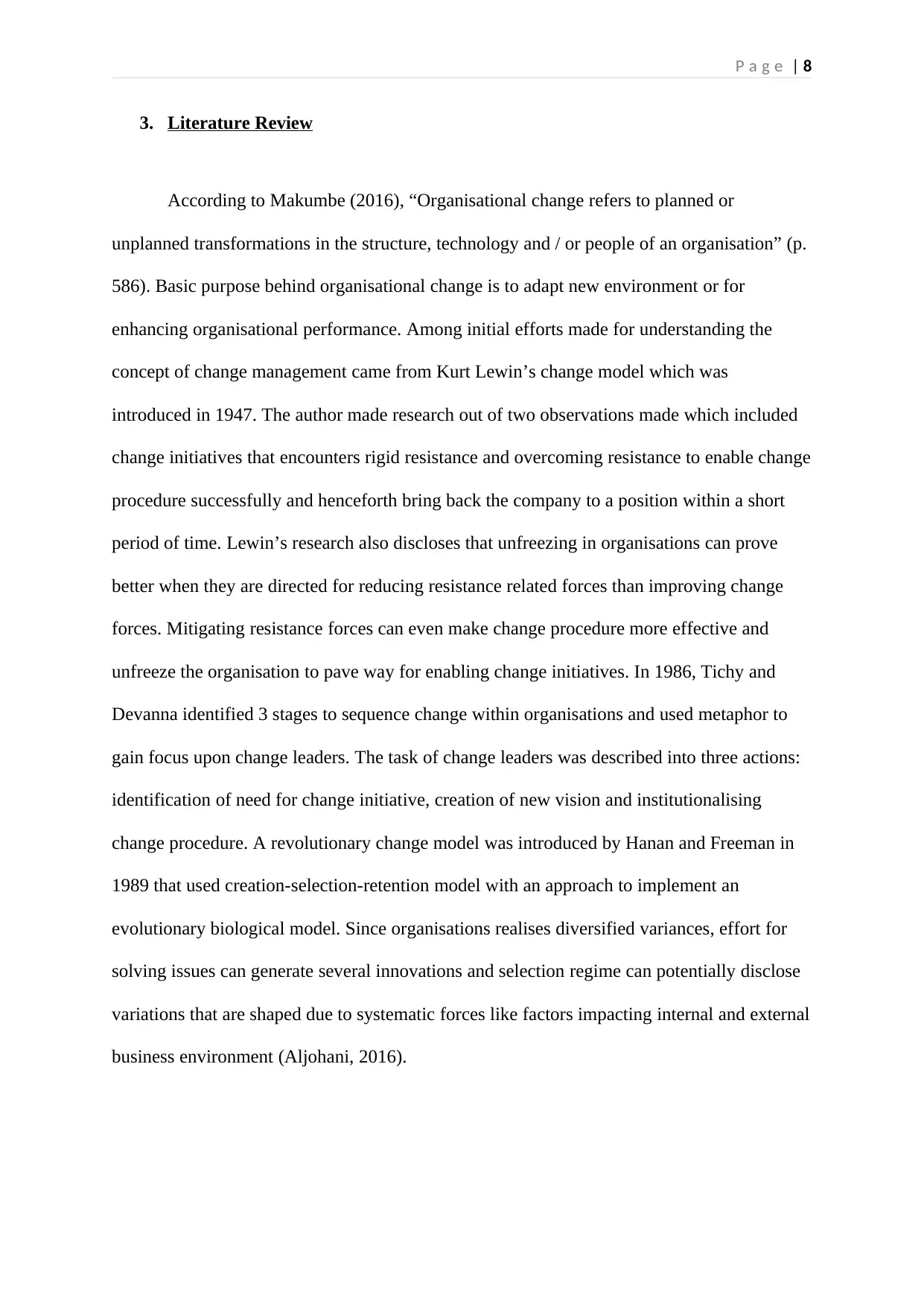
P a g e | 8
3. Literature Review
According to Makumbe (2016), “Organisational change refers to planned or
unplanned transformations in the structure, technology and / or people of an organisation” (p.
586). Basic purpose behind organisational change is to adapt new environment or for
enhancing organisational performance. Among initial efforts made for understanding the
concept of change management came from Kurt Lewin’s change model which was
introduced in 1947. The author made research out of two observations made which included
change initiatives that encounters rigid resistance and overcoming resistance to enable change
procedure successfully and henceforth bring back the company to a position within a short
period of time. Lewin’s research also discloses that unfreezing in organisations can prove
better when they are directed for reducing resistance related forces than improving change
forces. Mitigating resistance forces can even make change procedure more effective and
unfreeze the organisation to pave way for enabling change initiatives. In 1986, Tichy and
Devanna identified 3 stages to sequence change within organisations and used metaphor to
gain focus upon change leaders. The task of change leaders was described into three actions:
identification of need for change initiative, creation of new vision and institutionalising
change procedure. A revolutionary change model was introduced by Hanan and Freeman in
1989 that used creation-selection-retention model with an approach to implement an
evolutionary biological model. Since organisations realises diversified variances, effort for
solving issues can generate several innovations and selection regime can potentially disclose
variations that are shaped due to systematic forces like factors impacting internal and external
business environment (Aljohani, 2016).
3. Literature Review
According to Makumbe (2016), “Organisational change refers to planned or
unplanned transformations in the structure, technology and / or people of an organisation” (p.
586). Basic purpose behind organisational change is to adapt new environment or for
enhancing organisational performance. Among initial efforts made for understanding the
concept of change management came from Kurt Lewin’s change model which was
introduced in 1947. The author made research out of two observations made which included
change initiatives that encounters rigid resistance and overcoming resistance to enable change
procedure successfully and henceforth bring back the company to a position within a short
period of time. Lewin’s research also discloses that unfreezing in organisations can prove
better when they are directed for reducing resistance related forces than improving change
forces. Mitigating resistance forces can even make change procedure more effective and
unfreeze the organisation to pave way for enabling change initiatives. In 1986, Tichy and
Devanna identified 3 stages to sequence change within organisations and used metaphor to
gain focus upon change leaders. The task of change leaders was described into three actions:
identification of need for change initiative, creation of new vision and institutionalising
change procedure. A revolutionary change model was introduced by Hanan and Freeman in
1989 that used creation-selection-retention model with an approach to implement an
evolutionary biological model. Since organisations realises diversified variances, effort for
solving issues can generate several innovations and selection regime can potentially disclose
variations that are shaped due to systematic forces like factors impacting internal and external
business environment (Aljohani, 2016).
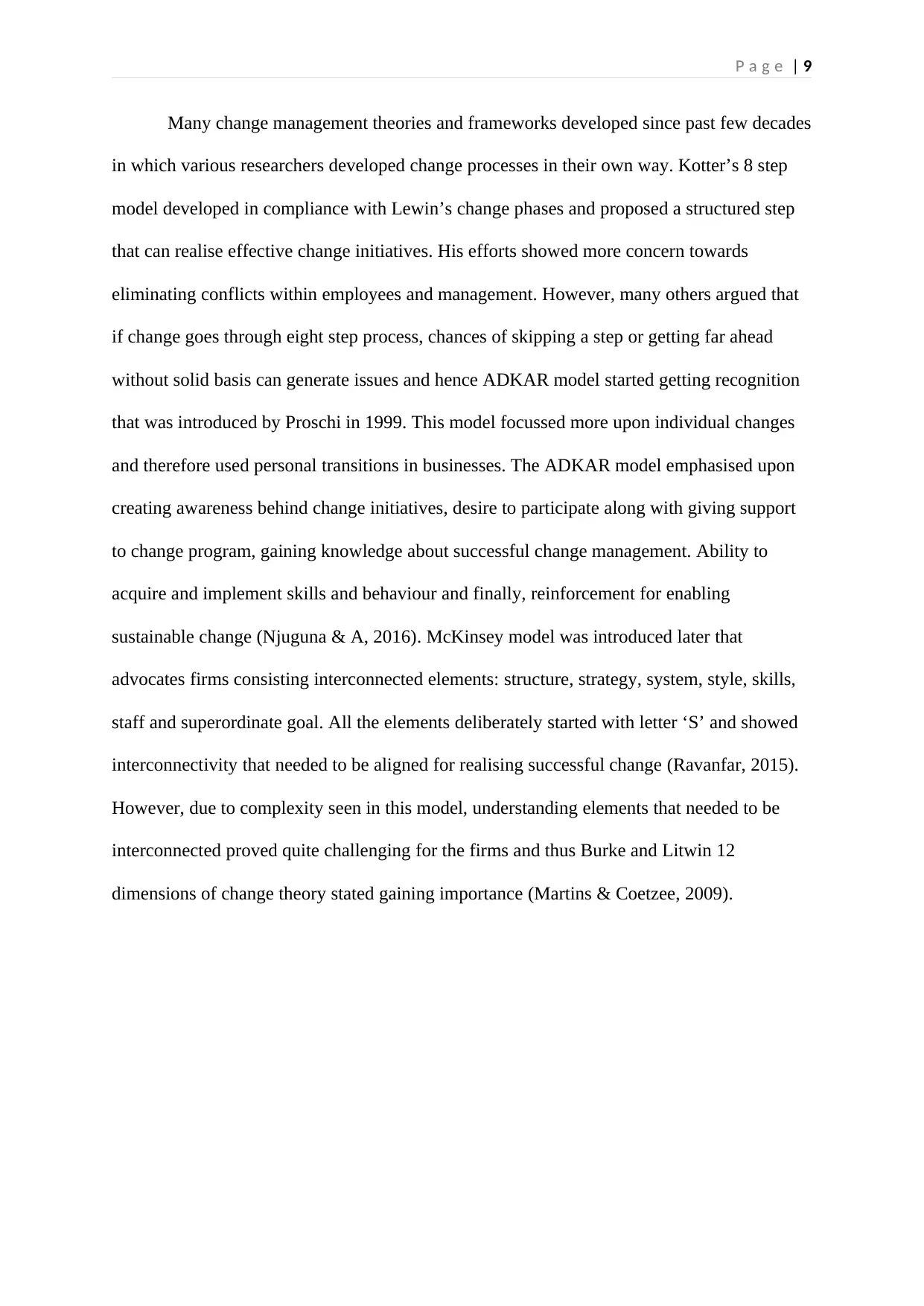
P a g e | 9
Many change management theories and frameworks developed since past few decades
in which various researchers developed change processes in their own way. Kotter’s 8 step
model developed in compliance with Lewin’s change phases and proposed a structured step
that can realise effective change initiatives. His efforts showed more concern towards
eliminating conflicts within employees and management. However, many others argued that
if change goes through eight step process, chances of skipping a step or getting far ahead
without solid basis can generate issues and hence ADKAR model started getting recognition
that was introduced by Proschi in 1999. This model focussed more upon individual changes
and therefore used personal transitions in businesses. The ADKAR model emphasised upon
creating awareness behind change initiatives, desire to participate along with giving support
to change program, gaining knowledge about successful change management. Ability to
acquire and implement skills and behaviour and finally, reinforcement for enabling
sustainable change (Njuguna & A, 2016). McKinsey model was introduced later that
advocates firms consisting interconnected elements: structure, strategy, system, style, skills,
staff and superordinate goal. All the elements deliberately started with letter ‘S’ and showed
interconnectivity that needed to be aligned for realising successful change (Ravanfar, 2015).
However, due to complexity seen in this model, understanding elements that needed to be
interconnected proved quite challenging for the firms and thus Burke and Litwin 12
dimensions of change theory stated gaining importance (Martins & Coetzee, 2009).
Many change management theories and frameworks developed since past few decades
in which various researchers developed change processes in their own way. Kotter’s 8 step
model developed in compliance with Lewin’s change phases and proposed a structured step
that can realise effective change initiatives. His efforts showed more concern towards
eliminating conflicts within employees and management. However, many others argued that
if change goes through eight step process, chances of skipping a step or getting far ahead
without solid basis can generate issues and hence ADKAR model started getting recognition
that was introduced by Proschi in 1999. This model focussed more upon individual changes
and therefore used personal transitions in businesses. The ADKAR model emphasised upon
creating awareness behind change initiatives, desire to participate along with giving support
to change program, gaining knowledge about successful change management. Ability to
acquire and implement skills and behaviour and finally, reinforcement for enabling
sustainable change (Njuguna & A, 2016). McKinsey model was introduced later that
advocates firms consisting interconnected elements: structure, strategy, system, style, skills,
staff and superordinate goal. All the elements deliberately started with letter ‘S’ and showed
interconnectivity that needed to be aligned for realising successful change (Ravanfar, 2015).
However, due to complexity seen in this model, understanding elements that needed to be
interconnected proved quite challenging for the firms and thus Burke and Litwin 12
dimensions of change theory stated gaining importance (Martins & Coetzee, 2009).
Secure Best Marks with AI Grader
Need help grading? Try our AI Grader for instant feedback on your assignments.
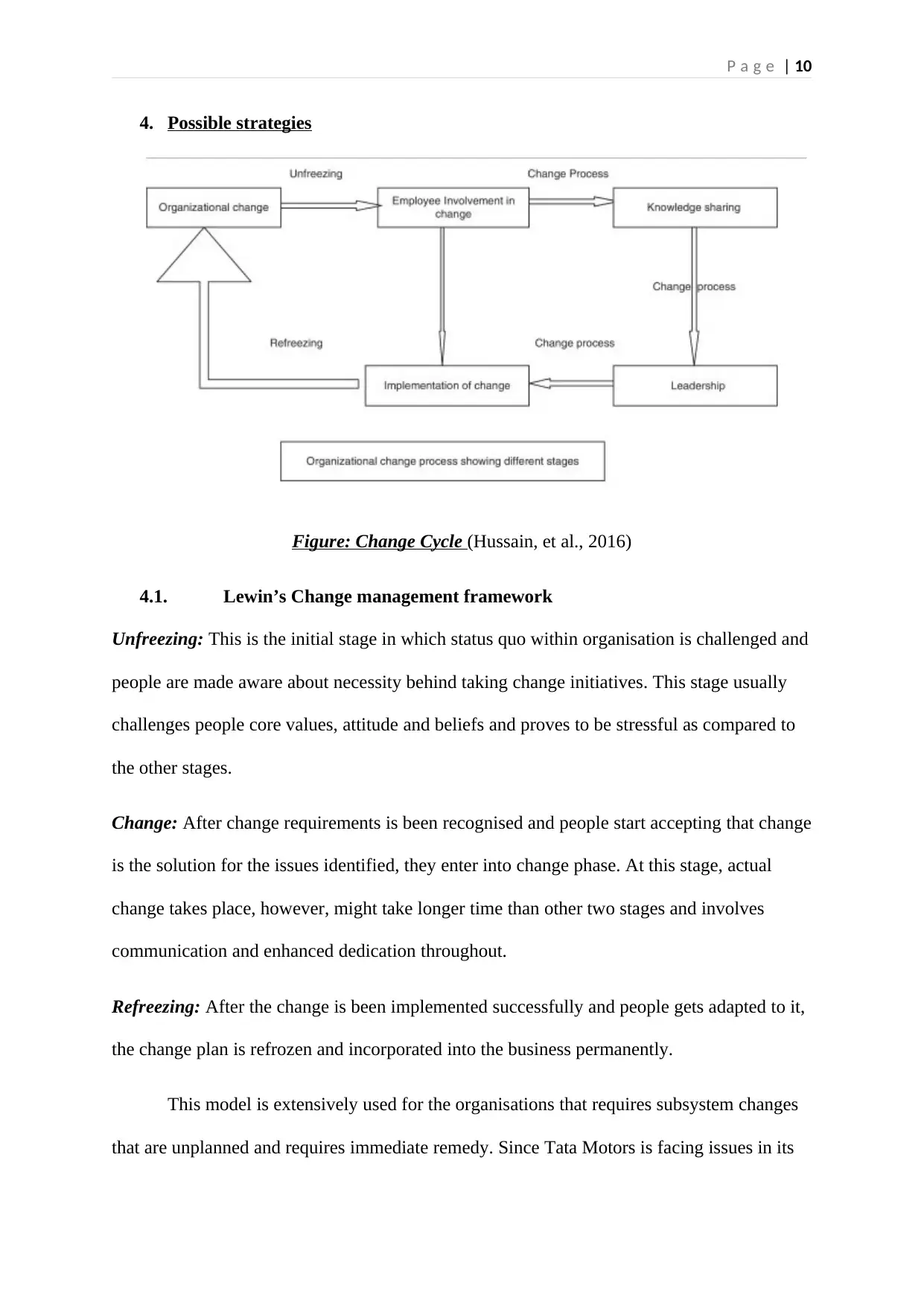
P a g e | 10
4. Possible strategies
Figure: Change Cycle (Hussain, et al., 2016)
4.1. Lewin’s Change management framework
Unfreezing: This is the initial stage in which status quo within organisation is challenged and
people are made aware about necessity behind taking change initiatives. This stage usually
challenges people core values, attitude and beliefs and proves to be stressful as compared to
the other stages.
Change: After change requirements is been recognised and people start accepting that change
is the solution for the issues identified, they enter into change phase. At this stage, actual
change takes place, however, might take longer time than other two stages and involves
communication and enhanced dedication throughout.
Refreezing: After the change is been implemented successfully and people gets adapted to it,
the change plan is refrozen and incorporated into the business permanently.
This model is extensively used for the organisations that requires subsystem changes
that are unplanned and requires immediate remedy. Since Tata Motors is facing issues in its
4. Possible strategies
Figure: Change Cycle (Hussain, et al., 2016)
4.1. Lewin’s Change management framework
Unfreezing: This is the initial stage in which status quo within organisation is challenged and
people are made aware about necessity behind taking change initiatives. This stage usually
challenges people core values, attitude and beliefs and proves to be stressful as compared to
the other stages.
Change: After change requirements is been recognised and people start accepting that change
is the solution for the issues identified, they enter into change phase. At this stage, actual
change takes place, however, might take longer time than other two stages and involves
communication and enhanced dedication throughout.
Refreezing: After the change is been implemented successfully and people gets adapted to it,
the change plan is refrozen and incorporated into the business permanently.
This model is extensively used for the organisations that requires subsystem changes
that are unplanned and requires immediate remedy. Since Tata Motors is facing issues in its
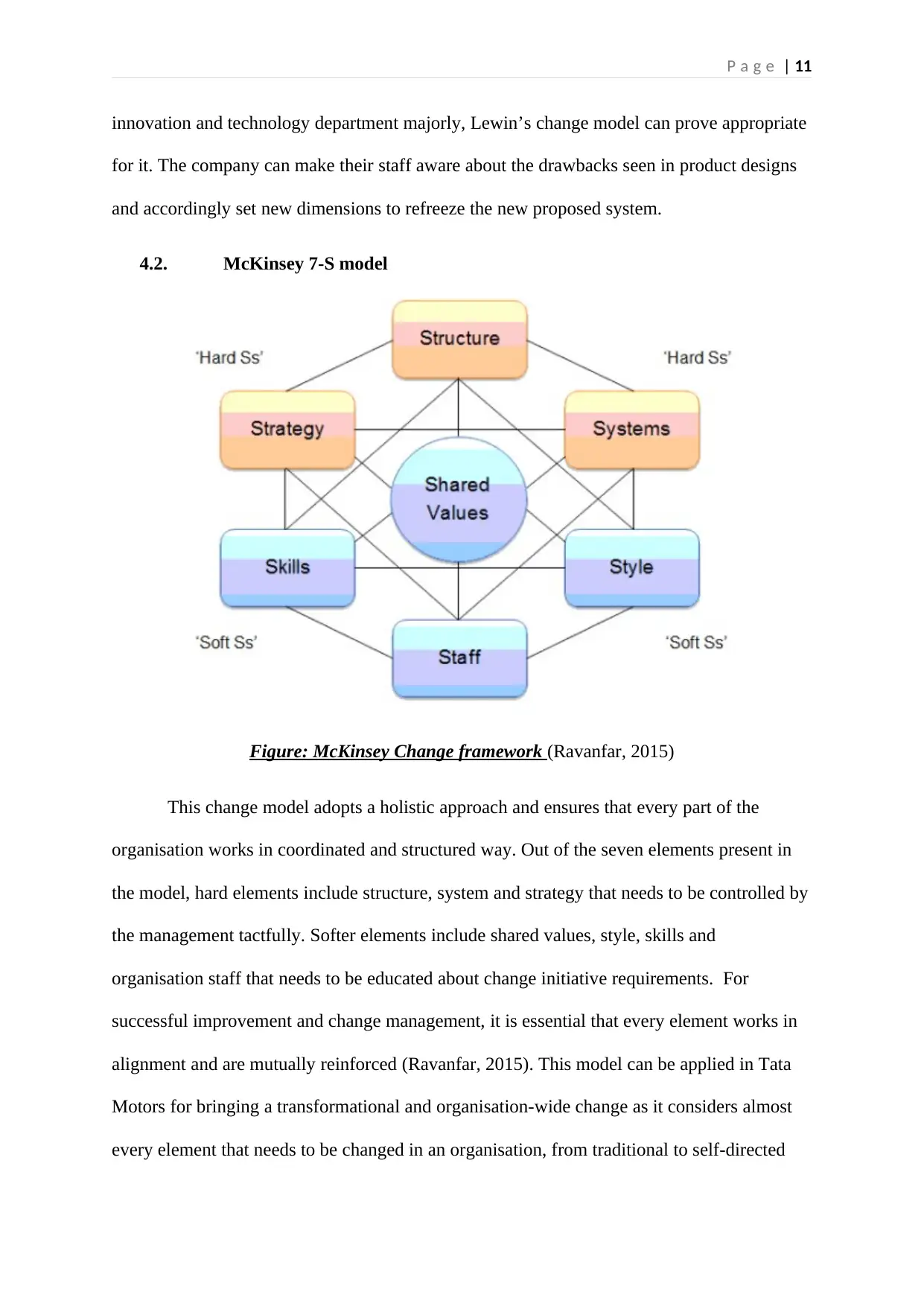
P a g e | 11
innovation and technology department majorly, Lewin’s change model can prove appropriate
for it. The company can make their staff aware about the drawbacks seen in product designs
and accordingly set new dimensions to refreeze the new proposed system.
4.2. McKinsey 7-S model
Figure: McKinsey Change framework (Ravanfar, 2015)
This change model adopts a holistic approach and ensures that every part of the
organisation works in coordinated and structured way. Out of the seven elements present in
the model, hard elements include structure, system and strategy that needs to be controlled by
the management tactfully. Softer elements include shared values, style, skills and
organisation staff that needs to be educated about change initiative requirements. For
successful improvement and change management, it is essential that every element works in
alignment and are mutually reinforced (Ravanfar, 2015). This model can be applied in Tata
Motors for bringing a transformational and organisation-wide change as it considers almost
every element that needs to be changed in an organisation, from traditional to self-directed
innovation and technology department majorly, Lewin’s change model can prove appropriate
for it. The company can make their staff aware about the drawbacks seen in product designs
and accordingly set new dimensions to refreeze the new proposed system.
4.2. McKinsey 7-S model
Figure: McKinsey Change framework (Ravanfar, 2015)
This change model adopts a holistic approach and ensures that every part of the
organisation works in coordinated and structured way. Out of the seven elements present in
the model, hard elements include structure, system and strategy that needs to be controlled by
the management tactfully. Softer elements include shared values, style, skills and
organisation staff that needs to be educated about change initiative requirements. For
successful improvement and change management, it is essential that every element works in
alignment and are mutually reinforced (Ravanfar, 2015). This model can be applied in Tata
Motors for bringing a transformational and organisation-wide change as it considers almost
every element that needs to be changed in an organisation, from traditional to self-directed
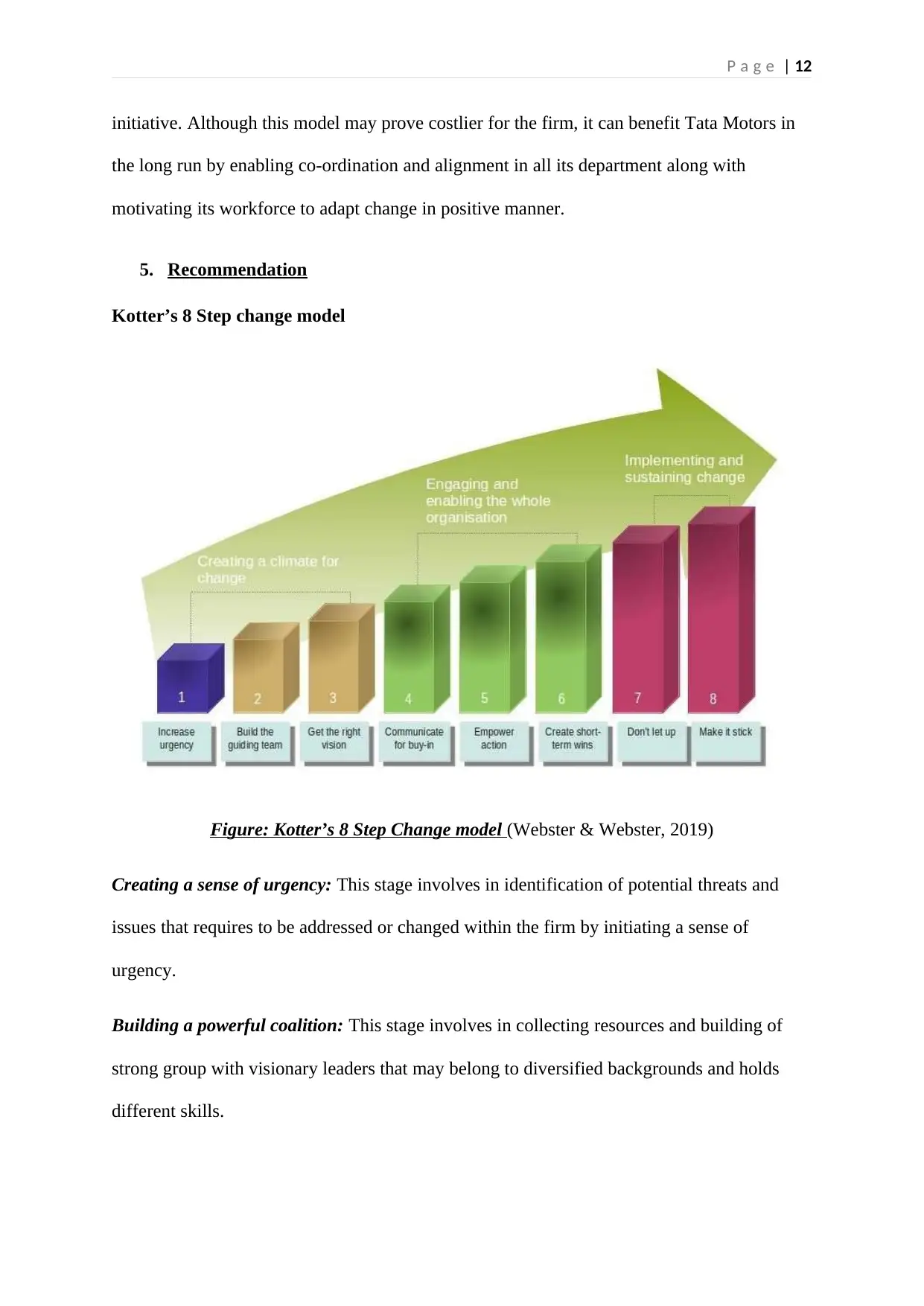
P a g e | 12
initiative. Although this model may prove costlier for the firm, it can benefit Tata Motors in
the long run by enabling co-ordination and alignment in all its department along with
motivating its workforce to adapt change in positive manner.
5. Recommendation
Kotter’s 8 Step change model
Figure: Kotter’s 8 Step Change model (Webster & Webster, 2019)
Creating a sense of urgency: This stage involves in identification of potential threats and
issues that requires to be addressed or changed within the firm by initiating a sense of
urgency.
Building a powerful coalition: This stage involves in collecting resources and building of
strong group with visionary leaders that may belong to diversified backgrounds and holds
different skills.
initiative. Although this model may prove costlier for the firm, it can benefit Tata Motors in
the long run by enabling co-ordination and alignment in all its department along with
motivating its workforce to adapt change in positive manner.
5. Recommendation
Kotter’s 8 Step change model
Figure: Kotter’s 8 Step Change model (Webster & Webster, 2019)
Creating a sense of urgency: This stage involves in identification of potential threats and
issues that requires to be addressed or changed within the firm by initiating a sense of
urgency.
Building a powerful coalition: This stage involves in collecting resources and building of
strong group with visionary leaders that may belong to diversified backgrounds and holds
different skills.
Paraphrase This Document
Need a fresh take? Get an instant paraphrase of this document with our AI Paraphraser
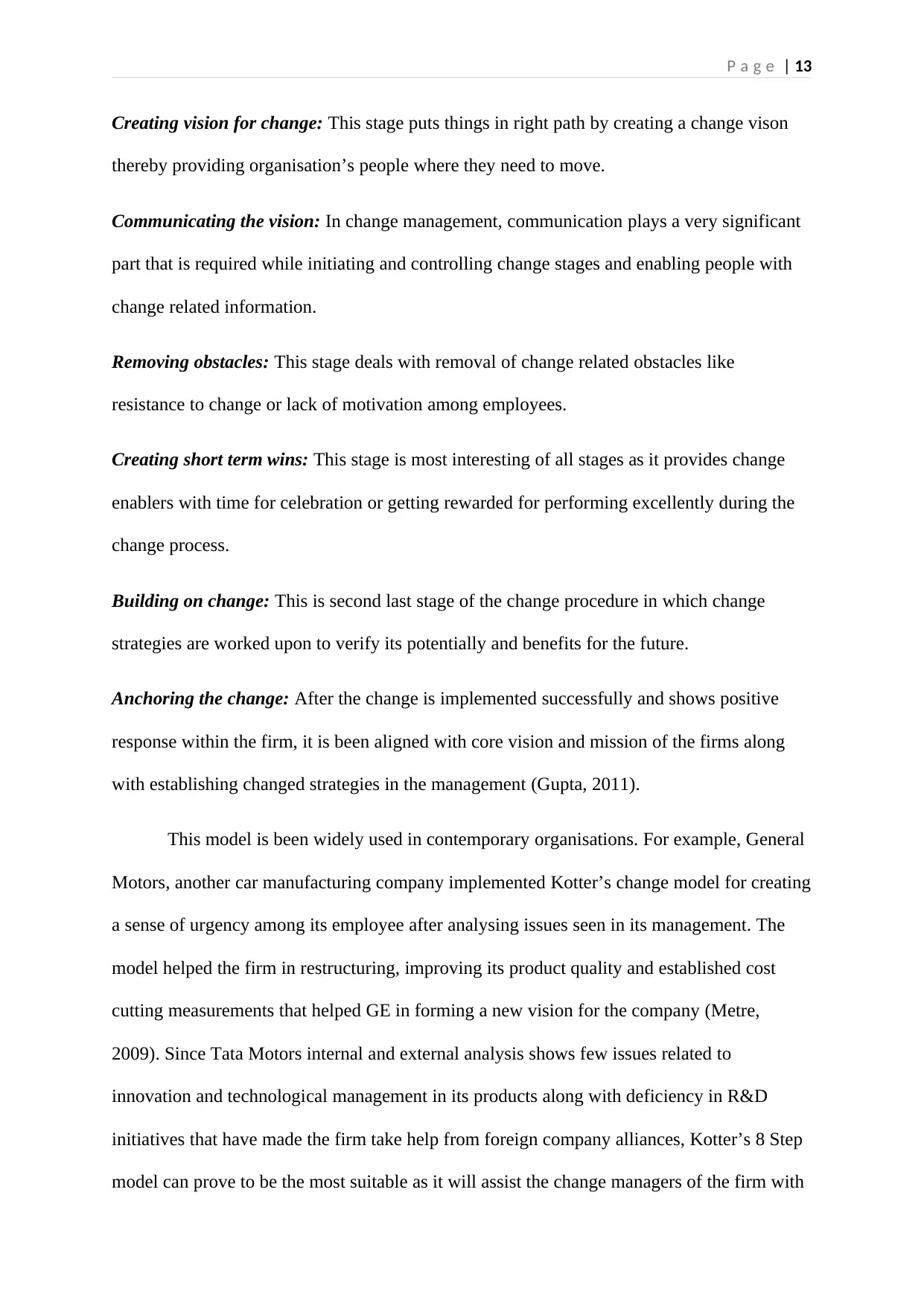
P a g e | 13
Creating vision for change: This stage puts things in right path by creating a change vison
thereby providing organisation’s people where they need to move.
Communicating the vision: In change management, communication plays a very significant
part that is required while initiating and controlling change stages and enabling people with
change related information.
Removing obstacles: This stage deals with removal of change related obstacles like
resistance to change or lack of motivation among employees.
Creating short term wins: This stage is most interesting of all stages as it provides change
enablers with time for celebration or getting rewarded for performing excellently during the
change process.
Building on change: This is second last stage of the change procedure in which change
strategies are worked upon to verify its potentially and benefits for the future.
Anchoring the change: After the change is implemented successfully and shows positive
response within the firm, it is been aligned with core vision and mission of the firms along
with establishing changed strategies in the management (Gupta, 2011).
This model is been widely used in contemporary organisations. For example, General
Motors, another car manufacturing company implemented Kotter’s change model for creating
a sense of urgency among its employee after analysing issues seen in its management. The
model helped the firm in restructuring, improving its product quality and established cost
cutting measurements that helped GE in forming a new vision for the company (Metre,
2009). Since Tata Motors internal and external analysis shows few issues related to
innovation and technological management in its products along with deficiency in R&D
initiatives that have made the firm take help from foreign company alliances, Kotter’s 8 Step
model can prove to be the most suitable as it will assist the change managers of the firm with
Creating vision for change: This stage puts things in right path by creating a change vison
thereby providing organisation’s people where they need to move.
Communicating the vision: In change management, communication plays a very significant
part that is required while initiating and controlling change stages and enabling people with
change related information.
Removing obstacles: This stage deals with removal of change related obstacles like
resistance to change or lack of motivation among employees.
Creating short term wins: This stage is most interesting of all stages as it provides change
enablers with time for celebration or getting rewarded for performing excellently during the
change process.
Building on change: This is second last stage of the change procedure in which change
strategies are worked upon to verify its potentially and benefits for the future.
Anchoring the change: After the change is implemented successfully and shows positive
response within the firm, it is been aligned with core vision and mission of the firms along
with establishing changed strategies in the management (Gupta, 2011).
This model is been widely used in contemporary organisations. For example, General
Motors, another car manufacturing company implemented Kotter’s change model for creating
a sense of urgency among its employee after analysing issues seen in its management. The
model helped the firm in restructuring, improving its product quality and established cost
cutting measurements that helped GE in forming a new vision for the company (Metre,
2009). Since Tata Motors internal and external analysis shows few issues related to
innovation and technological management in its products along with deficiency in R&D
initiatives that have made the firm take help from foreign company alliances, Kotter’s 8 Step
model can prove to be the most suitable as it will assist the change managers of the firm with
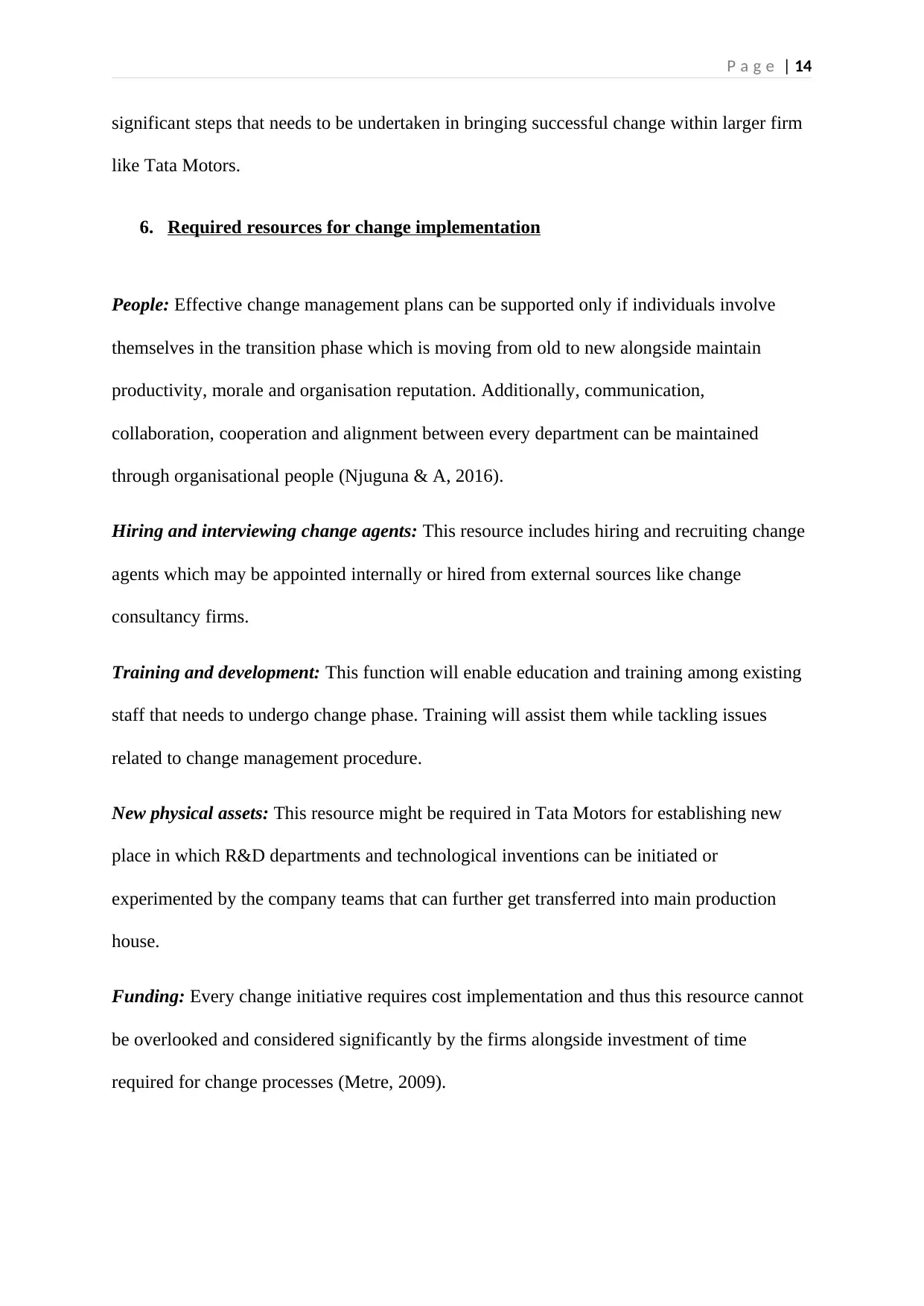
P a g e | 14
significant steps that needs to be undertaken in bringing successful change within larger firm
like Tata Motors.
6. Required resources for change implementation
People: Effective change management plans can be supported only if individuals involve
themselves in the transition phase which is moving from old to new alongside maintain
productivity, morale and organisation reputation. Additionally, communication,
collaboration, cooperation and alignment between every department can be maintained
through organisational people (Njuguna & A, 2016).
Hiring and interviewing change agents: This resource includes hiring and recruiting change
agents which may be appointed internally or hired from external sources like change
consultancy firms.
Training and development: This function will enable education and training among existing
staff that needs to undergo change phase. Training will assist them while tackling issues
related to change management procedure.
New physical assets: This resource might be required in Tata Motors for establishing new
place in which R&D departments and technological inventions can be initiated or
experimented by the company teams that can further get transferred into main production
house.
Funding: Every change initiative requires cost implementation and thus this resource cannot
be overlooked and considered significantly by the firms alongside investment of time
required for change processes (Metre, 2009).
significant steps that needs to be undertaken in bringing successful change within larger firm
like Tata Motors.
6. Required resources for change implementation
People: Effective change management plans can be supported only if individuals involve
themselves in the transition phase which is moving from old to new alongside maintain
productivity, morale and organisation reputation. Additionally, communication,
collaboration, cooperation and alignment between every department can be maintained
through organisational people (Njuguna & A, 2016).
Hiring and interviewing change agents: This resource includes hiring and recruiting change
agents which may be appointed internally or hired from external sources like change
consultancy firms.
Training and development: This function will enable education and training among existing
staff that needs to undergo change phase. Training will assist them while tackling issues
related to change management procedure.
New physical assets: This resource might be required in Tata Motors for establishing new
place in which R&D departments and technological inventions can be initiated or
experimented by the company teams that can further get transferred into main production
house.
Funding: Every change initiative requires cost implementation and thus this resource cannot
be overlooked and considered significantly by the firms alongside investment of time
required for change processes (Metre, 2009).
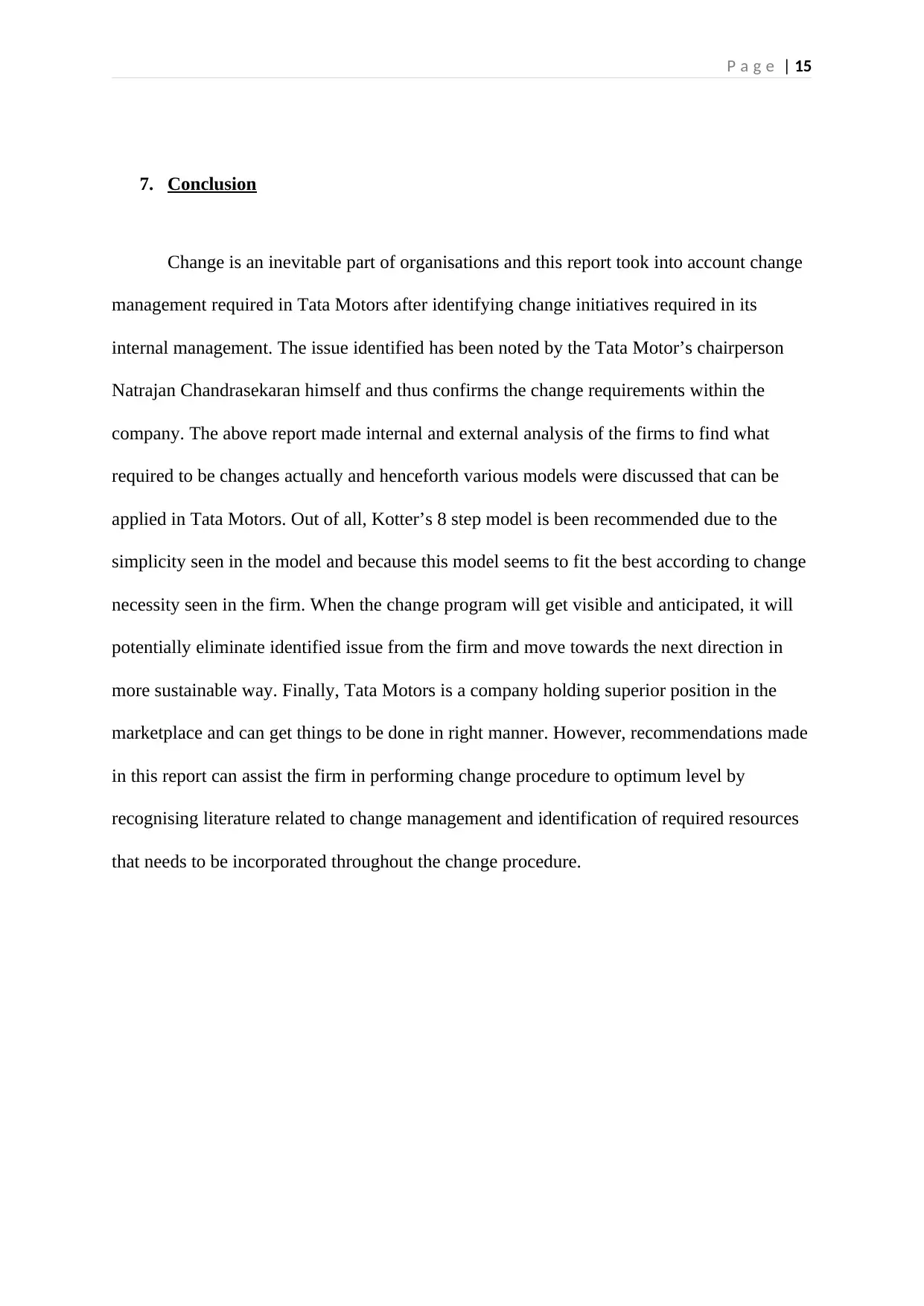
P a g e | 15
7. Conclusion
Change is an inevitable part of organisations and this report took into account change
management required in Tata Motors after identifying change initiatives required in its
internal management. The issue identified has been noted by the Tata Motor’s chairperson
Natrajan Chandrasekaran himself and thus confirms the change requirements within the
company. The above report made internal and external analysis of the firms to find what
required to be changes actually and henceforth various models were discussed that can be
applied in Tata Motors. Out of all, Kotter’s 8 step model is been recommended due to the
simplicity seen in the model and because this model seems to fit the best according to change
necessity seen in the firm. When the change program will get visible and anticipated, it will
potentially eliminate identified issue from the firm and move towards the next direction in
more sustainable way. Finally, Tata Motors is a company holding superior position in the
marketplace and can get things to be done in right manner. However, recommendations made
in this report can assist the firm in performing change procedure to optimum level by
recognising literature related to change management and identification of required resources
that needs to be incorporated throughout the change procedure.
7. Conclusion
Change is an inevitable part of organisations and this report took into account change
management required in Tata Motors after identifying change initiatives required in its
internal management. The issue identified has been noted by the Tata Motor’s chairperson
Natrajan Chandrasekaran himself and thus confirms the change requirements within the
company. The above report made internal and external analysis of the firms to find what
required to be changes actually and henceforth various models were discussed that can be
applied in Tata Motors. Out of all, Kotter’s 8 step model is been recommended due to the
simplicity seen in the model and because this model seems to fit the best according to change
necessity seen in the firm. When the change program will get visible and anticipated, it will
potentially eliminate identified issue from the firm and move towards the next direction in
more sustainable way. Finally, Tata Motors is a company holding superior position in the
marketplace and can get things to be done in right manner. However, recommendations made
in this report can assist the firm in performing change procedure to optimum level by
recognising literature related to change management and identification of required resources
that needs to be incorporated throughout the change procedure.
Secure Best Marks with AI Grader
Need help grading? Try our AI Grader for instant feedback on your assignments.
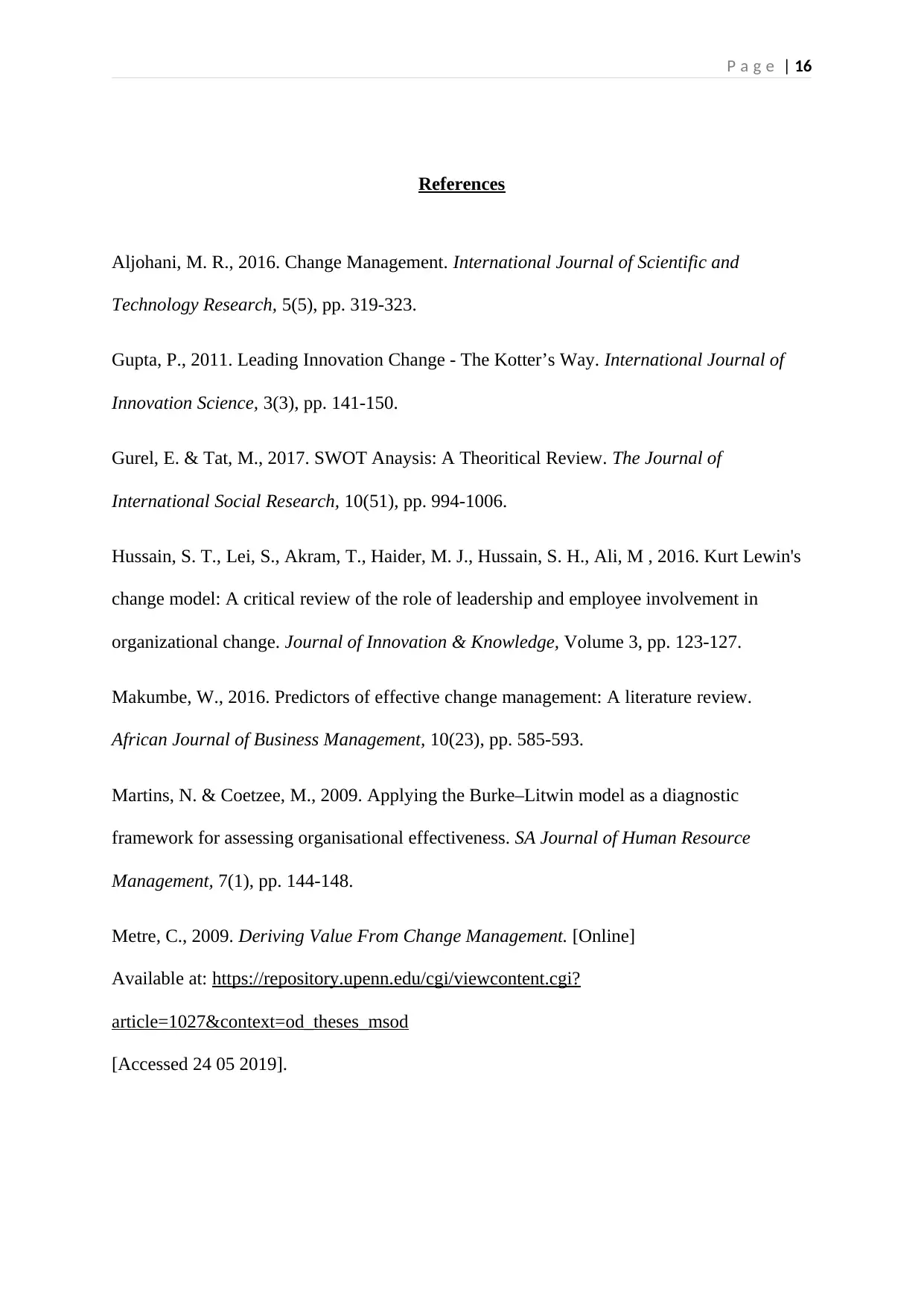
P a g e | 16
References
Aljohani, M. R., 2016. Change Management. International Journal of Scientific and
Technology Research, 5(5), pp. 319-323.
Gupta, P., 2011. Leading Innovation Change - The Kotter’s Way. International Journal of
Innovation Science, 3(3), pp. 141-150.
Gurel, E. & Tat, M., 2017. SWOT Anaysis: A Theoritical Review. The Journal of
International Social Research, 10(51), pp. 994-1006.
Hussain, S. T., Lei, S., Akram, T., Haider, M. J., Hussain, S. H., Ali, M , 2016. Kurt Lewin's
change model: A critical review of the role of leadership and employee involvement in
organizational change. Journal of Innovation & Knowledge, Volume 3, pp. 123-127.
Makumbe, W., 2016. Predictors of effective change management: A literature review.
African Journal of Business Management, 10(23), pp. 585-593.
Martins, N. & Coetzee, M., 2009. Applying the Burke–Litwin model as a diagnostic
framework for assessing organisational effectiveness. SA Journal of Human Resource
Management, 7(1), pp. 144-148.
Metre, C., 2009. Deriving Value From Change Management. [Online]
Available at: https://repository.upenn.edu/cgi/viewcontent.cgi?
article=1027&context=od_theses_msod
[Accessed 24 05 2019].
References
Aljohani, M. R., 2016. Change Management. International Journal of Scientific and
Technology Research, 5(5), pp. 319-323.
Gupta, P., 2011. Leading Innovation Change - The Kotter’s Way. International Journal of
Innovation Science, 3(3), pp. 141-150.
Gurel, E. & Tat, M., 2017. SWOT Anaysis: A Theoritical Review. The Journal of
International Social Research, 10(51), pp. 994-1006.
Hussain, S. T., Lei, S., Akram, T., Haider, M. J., Hussain, S. H., Ali, M , 2016. Kurt Lewin's
change model: A critical review of the role of leadership and employee involvement in
organizational change. Journal of Innovation & Knowledge, Volume 3, pp. 123-127.
Makumbe, W., 2016. Predictors of effective change management: A literature review.
African Journal of Business Management, 10(23), pp. 585-593.
Martins, N. & Coetzee, M., 2009. Applying the Burke–Litwin model as a diagnostic
framework for assessing organisational effectiveness. SA Journal of Human Resource
Management, 7(1), pp. 144-148.
Metre, C., 2009. Deriving Value From Change Management. [Online]
Available at: https://repository.upenn.edu/cgi/viewcontent.cgi?
article=1027&context=od_theses_msod
[Accessed 24 05 2019].

P a g e | 17
Njuguna, E. N. A. A. & A, M. S., 2016. Critical Review of Literature on Change
Management on Employees Performance. International Journal of Research In Social
Sciences, 6(3), pp. 9-22.
Ravanfar, M. M., 2015. Analyzing Organizational Structure Based on 7s Model of Mckinsey.
Global Journal of Management and Business Research: A Administration and Management,
15(10), pp. 7-12.
Sammut-Bonnici , T. & Galea, D., 2015. PEST analysis. [Online]
Available at: https://www.researchgate.net/publication/257303449_PEST_analysis
[Accessed 24 05 2019].
Tata Motors, 2017. Tata Motors: Sustainability Report. [Online]
Available at: https://www.tatamotors.com/wp-content/uploads/2015/10/06100728/tml-
sustainability-report-2016-17.pdf
[Accessed 24 05 2019].
Tata Motors, 2018. 73rd Annual Report (Integrated). [Online]
Available at: https://www.tatamotors.com/wp-content/uploads/2018/07/12115930/Annual-
Report-2017-2018.pdf
[Accessed 24 05 2019].
Thakkar, K., 2018. Tata Motors need "specific interventions" to counter challenges in global
auto industry says Natrajan Chandrasekaran. [Online]
Available at: https://economictimes.indiatimes.com/industry/auto/auto-news/tata-motors-
need-specific-interventions-to-counter-challenges-in-global-auto-industry-says-natrajan-
chandrasekaran/articleshow/64973426.cms?from=mdr
[Accessed 23 05 2019].
Njuguna, E. N. A. A. & A, M. S., 2016. Critical Review of Literature on Change
Management on Employees Performance. International Journal of Research In Social
Sciences, 6(3), pp. 9-22.
Ravanfar, M. M., 2015. Analyzing Organizational Structure Based on 7s Model of Mckinsey.
Global Journal of Management and Business Research: A Administration and Management,
15(10), pp. 7-12.
Sammut-Bonnici , T. & Galea, D., 2015. PEST analysis. [Online]
Available at: https://www.researchgate.net/publication/257303449_PEST_analysis
[Accessed 24 05 2019].
Tata Motors, 2017. Tata Motors: Sustainability Report. [Online]
Available at: https://www.tatamotors.com/wp-content/uploads/2015/10/06100728/tml-
sustainability-report-2016-17.pdf
[Accessed 24 05 2019].
Tata Motors, 2018. 73rd Annual Report (Integrated). [Online]
Available at: https://www.tatamotors.com/wp-content/uploads/2018/07/12115930/Annual-
Report-2017-2018.pdf
[Accessed 24 05 2019].
Thakkar, K., 2018. Tata Motors need "specific interventions" to counter challenges in global
auto industry says Natrajan Chandrasekaran. [Online]
Available at: https://economictimes.indiatimes.com/industry/auto/auto-news/tata-motors-
need-specific-interventions-to-counter-challenges-in-global-auto-industry-says-natrajan-
chandrasekaran/articleshow/64973426.cms?from=mdr
[Accessed 23 05 2019].
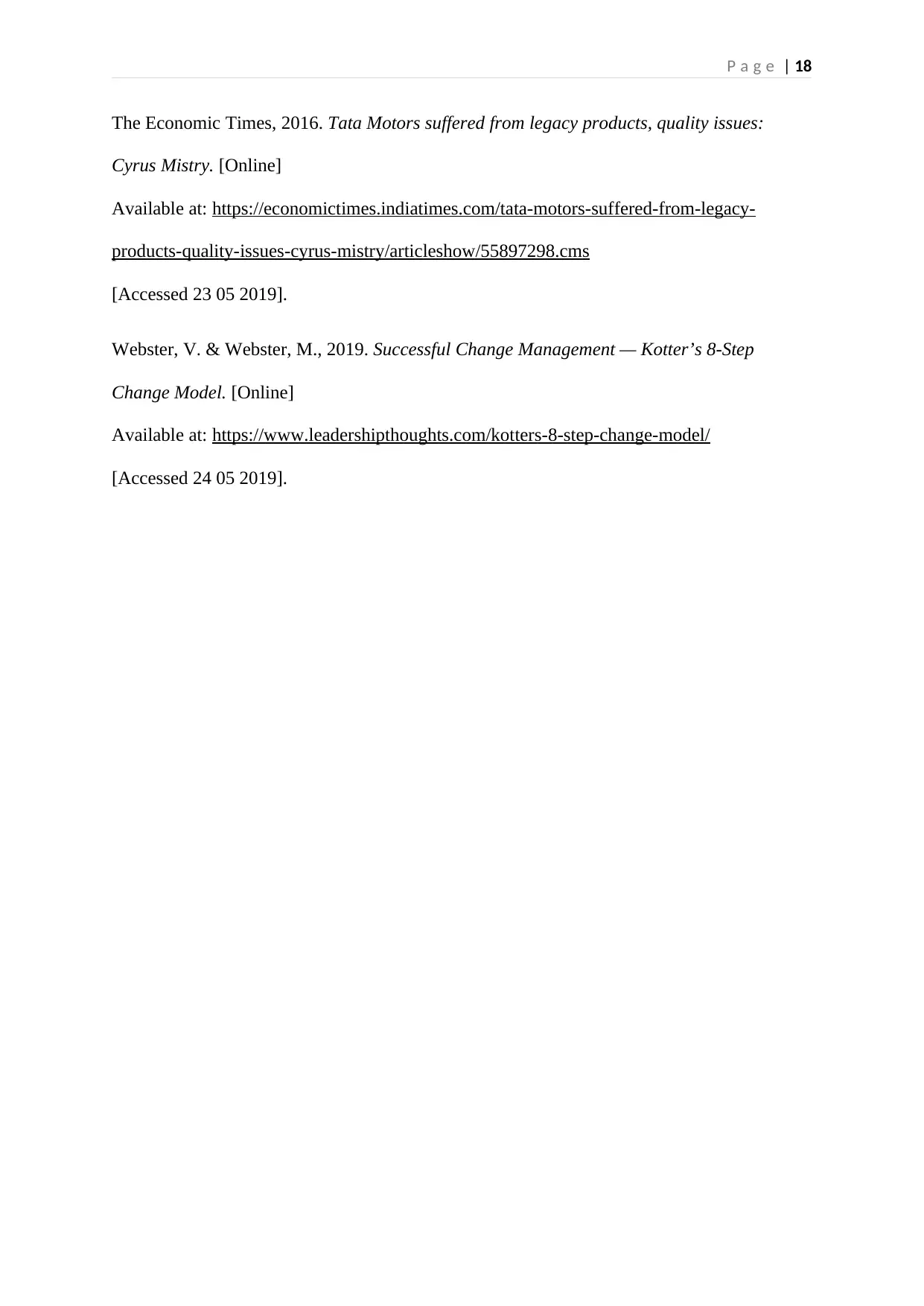
P a g e | 18
The Economic Times, 2016. Tata Motors suffered from legacy products, quality issues:
Cyrus Mistry. [Online]
Available at: https://economictimes.indiatimes.com/tata-motors-suffered-from-legacy-
products-quality-issues-cyrus-mistry/articleshow/55897298.cms
[Accessed 23 05 2019].
Webster, V. & Webster, M., 2019. Successful Change Management — Kotter’s 8-Step
Change Model. [Online]
Available at: https://www.leadershipthoughts.com/kotters-8-step-change-model/
[Accessed 24 05 2019].
The Economic Times, 2016. Tata Motors suffered from legacy products, quality issues:
Cyrus Mistry. [Online]
Available at: https://economictimes.indiatimes.com/tata-motors-suffered-from-legacy-
products-quality-issues-cyrus-mistry/articleshow/55897298.cms
[Accessed 23 05 2019].
Webster, V. & Webster, M., 2019. Successful Change Management — Kotter’s 8-Step
Change Model. [Online]
Available at: https://www.leadershipthoughts.com/kotters-8-step-change-model/
[Accessed 24 05 2019].
1 out of 19
Related Documents
Your All-in-One AI-Powered Toolkit for Academic Success.
+13062052269
info@desklib.com
Available 24*7 on WhatsApp / Email
![[object Object]](/_next/static/media/star-bottom.7253800d.svg)
Unlock your academic potential
© 2024 | Zucol Services PVT LTD | All rights reserved.





